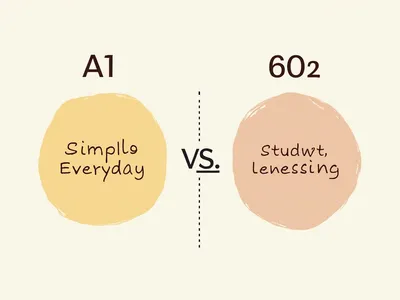
What are the key differences between A1 and A2 vocabulary levels
Key Differences Between A1 and A2 Vocabulary Levels
The Common European Framework of Reference for Languages (CEFR) categorizes language proficiency into six levels, with A1 and A2 representing the basic user levels. Here are the key distinctions between these two levels in terms of vocabulary:
****Vocabulary Size and Range
-
A1 Level: At this level, learners are expected to understand and use familiar everyday expressions and very basic phrases aimed at satisfying concrete needs. The vocabulary typically includes around 800 to 1,000 words, focusing on simple nouns, adjectives, and verbs related to personal information, family, shopping, and daily activities.
-
A2 Level: Learners at the A2 level expand their vocabulary to approximately 1,500 to 2,000 words. This includes a wider range of topics such as work, travel, and hobbies. The vocabulary becomes more varied and includes more complex structures, allowing for simple conversations about routine matters.
****Complexity of Vocabulary
-
A1 Level: The vocabulary is generally limited to very basic words that are commonly used in everyday situations. For example, learners might know words like “cat,” “house,” “go,” and “eat.”
-
A2 Level: Vocabulary at this level introduces more abstract concepts and a greater variety of word forms (e.g., plural forms, simple past tense). Learners can handle phrases like “I would like to go to the cinema” or “Can you help me with this?”
****Contextual Usage
-
A1 Level: Learners can use vocabulary in highly predictable contexts. They can respond to questions about themselves or their immediate environment but may struggle with unfamiliar topics.
-
A2 Level: At this level, learners can communicate in simple and routine tasks requiring a simple exchange of information on familiar topics. They can also describe their background and immediate environment in more detail.
****Examples of Vocabulary Topics
-
A1 Level Topics:
- Personal information (name, age)
- Family members
- Basic food items
- Colors and numbers
- Simple greetings and farewells
-
A2 Level Topics:
- Daily routines (e.g., describing what they do in a day)
- Shopping (e.g., asking for prices or quantities)
- Travel (e.g., directions, transportation)
- Hobbies and interests (e.g., sports, music)
In summary, the transition from A1 to A2 involves an increase in both the quantity and complexity of vocabulary. A2 learners can engage in more meaningful conversations about a broader range of topics than their A1 counterparts, reflecting their growing language proficiency.
References
-
Fostering the Teaching of Cultural Vocabulary in EFL Contexts
-
An Explanatory Comparison of Japanese Secondary English Textbooks and IB English Textbooks
-
Effect of Genetic Polymorphism of Bovine β-Casein Variants (A1 and A2) on Yoghurt Characteristics
-
ВЛИЯНИЕ ГОВОРОВ ХОРВАТСКОГО ЯЗЫКА НА УСВОЕНИЕ РУССКОГО УДАРЕНИЯ
-
EFFECT OF THE DIALECTS OF THE CROATIAN LANGUAGE ON THE DEVELOPMENT OF THE RUSSIAN ACCENT
-
Un momento o un attimo? La scelta di vocaboli nel libro di testo- uno studio comparativo
-
Differential Impact of Co-expressed SP-A1/SP-A2 Protein on AM miRNome; Sex Differences
-
Preliminary validation of the A1 and A2 sub-levels of the CEFR-J
-
Examining Thai First-Year University Students’ English Proficiency on CEFR Levels